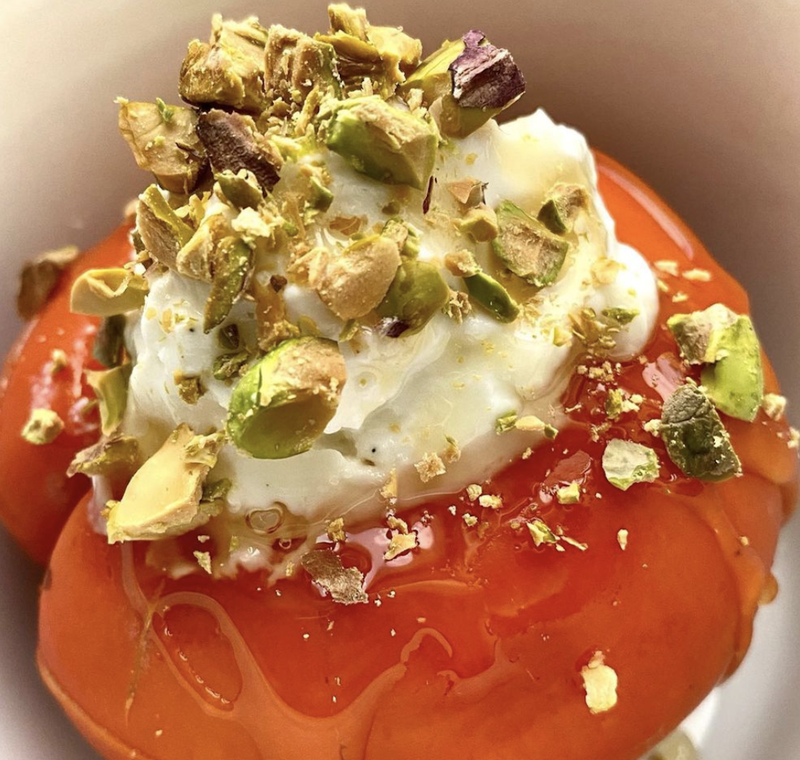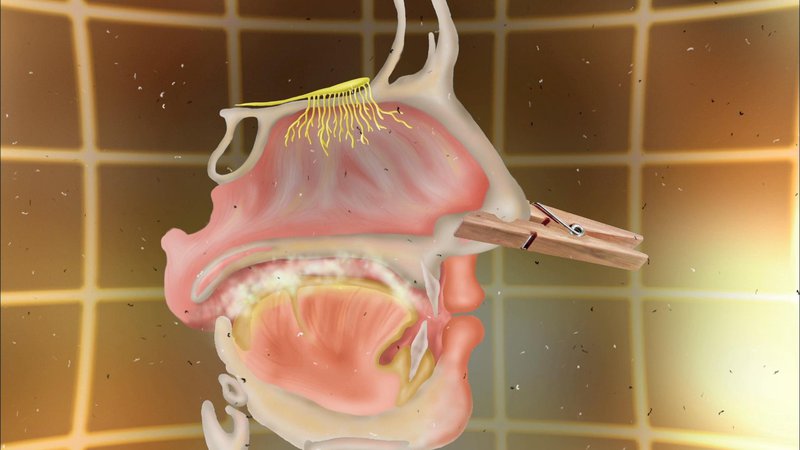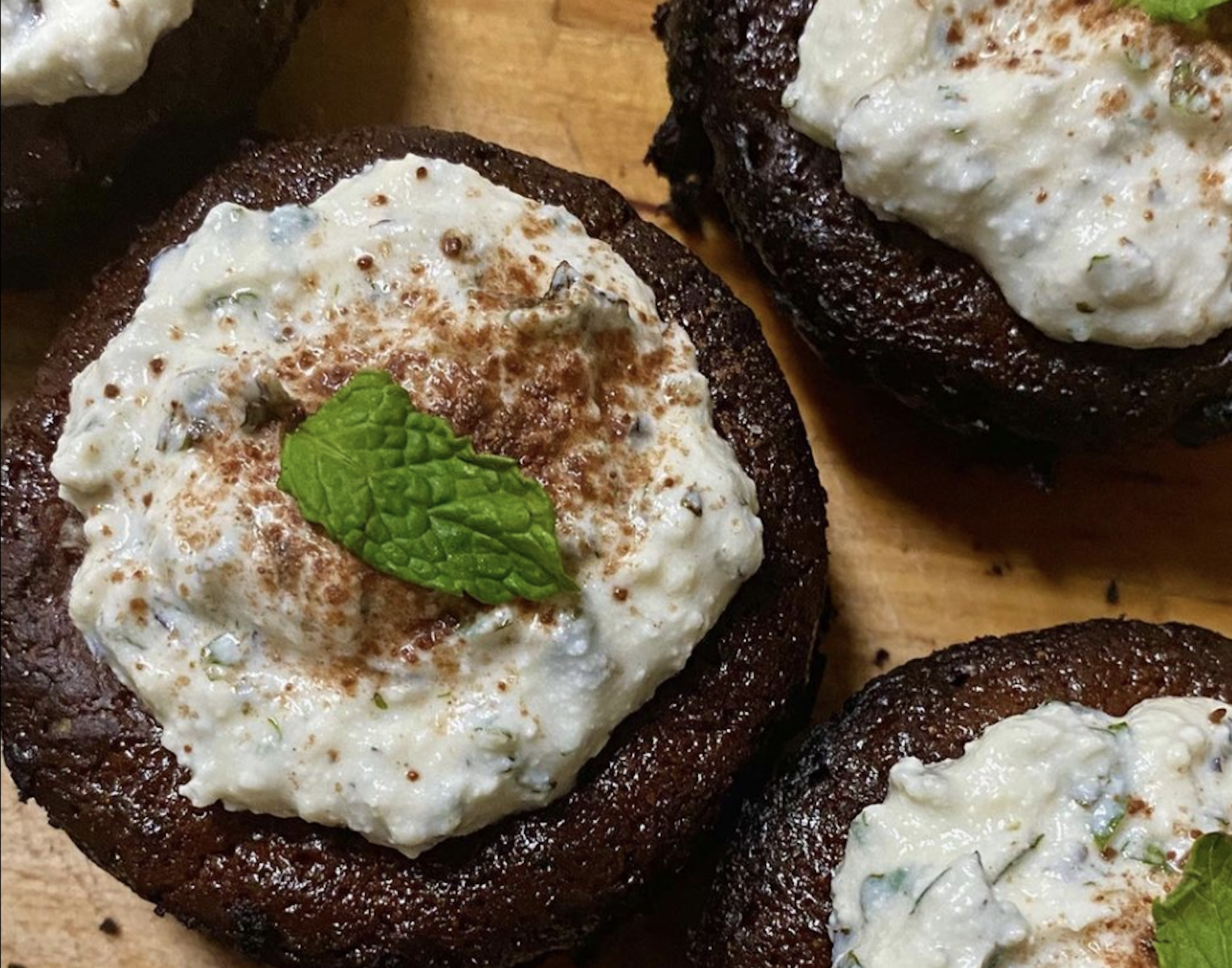Grapefruit-mint-marmalade chocolate lava mini cakes with fresh mint ricotta. Image Credit: Annie Wu
Use these NOVA resources to introduce students to neuroscience, chemistry, and biology concepts that explain the science behind flavor, and how smell, sight, and sound can influence the experience.
In early April, Annie Wu, a professional musician, began experiencing COVID-19 symptoms. During her self-imposed quarantine, Wu developed a symptom that an estimated 80% of people who contract COVD-19 report: anosmia, the loss of the sense of smell. Soon, she also experienced a loss of taste (ageusia). She remembers biting into a celery stick slathered in peanut butter and tasting nothing at all. “It was jarring, peanut butter tasted like tacky Elmer’s glue, coffee became warm dirt water,” she says.
Wu has since recovered from COVID-19, but has yet to fully regain her senses of smell and taste. Rather than dwell on this loss, the experience has transformed the way she connects with and thinks about food. Over the course of the past seven months, she has chronicled her journey online with her Instagram account “in search of lost smell” (@insearchoflostsmell).
As the months passed, smell maintained an elusive haze, but Wu’s taste began to sharpen as she ventured out of her comfort zone. Rather than dwell on what she was lacking, she started experimenting with flavor profiles that she had previously avoided. “There was a world of flavor to explore—vinegars, sugary glazes, citrus, fermented goods,” she says. “Taste can carry with it memories, reactions, and even excitement for the future.”

Through this process, Wu realized that smell is not just the firing of tingly nerves in our noses, but a connection to rapture, delight, and discovery. By sharing photos of her visually stimulating new meals with strangers on social media, she was surprised by the connections that she was able to develop with chefs who inspire her, teachers at food justice programs, food lovers from all over the world, and even those who had lost their own sense of smell and taste as well.
Throughout her experience chronicling the various recipes she is testing and sharing on social media, she has received descriptive messages about the way that various ingredients taste, with respondents often connecting flavor profiles to a feeling, certain memories, or a particular place that it reminds them of.
“You forget how much smell ties to these emotional parts of your life, like walking into your family childhood home,” Wu says.
Within the human nose, there are more than 12 million smell receptors (of about 400 different types), which are activated by millions of potential combinations of odor molecules. The receptors detect odor molecules and send information back to the olfactory bulb in the brain, where these scents are interpreted. The olfactory system is closely linked with the temporal lobe, which is responsible for emotion and memory.

This area of the brain is also home to the amygdala and hippocampus, which are critical for emotional learning, memory, and smell. This connection explains why certain smells may trigger vivid memories about past events. The hippocampus is also linked to our digestive system which helps regulate appetite, digestion, and eating behavior. Finding food was so critical to our survival as a species that scientists believe our brains evolved to form memories about and around food—including those that make us sick.
But what is it specifically about novelty candies, family recipes, or holiday dishes that make them so memorable after many years? When we eat highly appealing foods, such as chocolate, the neurotransmitter dopamine is released. This triggers the reward center of our brain and, when transmitted via the hippocampus, dopamine helps turn short-term memories into long-term ones.
This explains why our attraction to, or disgust with, certain foods lasts for years after tasting them. It is because of the connections between the olfactory system and regions of the brain responsible for emotion and memory that positive or negative flavor experiences can be long lasting.
With the holidays just around the corner, cherished family recipes and delectable side dishes are on everyone’s mind. Use these NOVA resources to introduce students to neuroscience, chemistry, and biology concepts that explain the science behind flavor, and how smell, sight, and sound can influence the experience.
NOVA Resources on PBS LearningMedia
NOVA: Can I Eat That? | The Science of Flavor
Learn more about the perception of flavor, and how dulling a person’s ability to smell can make something taste flavorless. Use this NOVA scienceNow resource to show students which parts of the body can help you experience flavor, how looks can be deceiving when tasting food items, and how sound provides information about food.
NOVA: Can I Eat That? | What is a Supertaster?
This video breaks down the science of taste buds and explains how the number of taste buds you have can affect the way that you interpret certain flavors. Learn why some people experience taste more intensely than others, and what evolutionary advantages “supertasters” have developed.
The Chemistry of Tender Turkey
Learn about the chemistry behind brining meat. Correspondent and New York Times technology columnist David Pogue explores how the process of brining can ensure a tender and moist cooked turkey. Use this NOVA scienceNOW resource to demonstrate how soaking a raw turkey in salt water adds moisture to the meat through the process of osmosis, and watch as Pogue participates in a taste test to identify samples of turkey cooked with and without brining.
NOVA Digital Resources
How Anosmia Could Affect Doctors’ Coronavirus Screenings
Learn more about the symptom that an estimated 80% of COVID-19 patients report experiencing. Use this NOVA video to help unpack the science behind how COVID-19 can cause smell loss and whether the condition is permanent.
Turn to Science for Great Thanksgiving Stuffing
What makes onions so oniony? Why does stuffing sometimes come out gummy? Learn the secret to making delicious stuffing with the perfect texture—and why chemical reactions and volatile molecules in onions might make you cry as you cut them.
NOVA Now Podcast: The Future of Food
In honor of celebrating nature’s bounty, NOVA Now podcast host Alok Patel considers the past, present, and future of food. He digs into the world of food science with the resident science guy at America’s Test Kitchen; speaks with an Indigenous community cook, educator, and community organizer about food sovereignty and equitable food systems; and checks in with a scientist who is genetically engineering plants to photosynthesize more efficiently to increase crop yields.
NOVA Science Café Resource
Much Ado About Stuffing: Answering Your Thanksgiving Cooking Questions
With COVID-19 keeping friends and family apart, Thanksgiving celebrations will look different than in years past. Lan Lam, Senior Editor at Cook’s Illustrated is here to answer all of your last minute Thanksgiving cooking questions—from the calculations to reduce recipe sizes to science-backed ways to get the most flavor from your food.
Source: Bring the Science of Taste into the Classroom with NOVA Resources | NOVA | PBS













